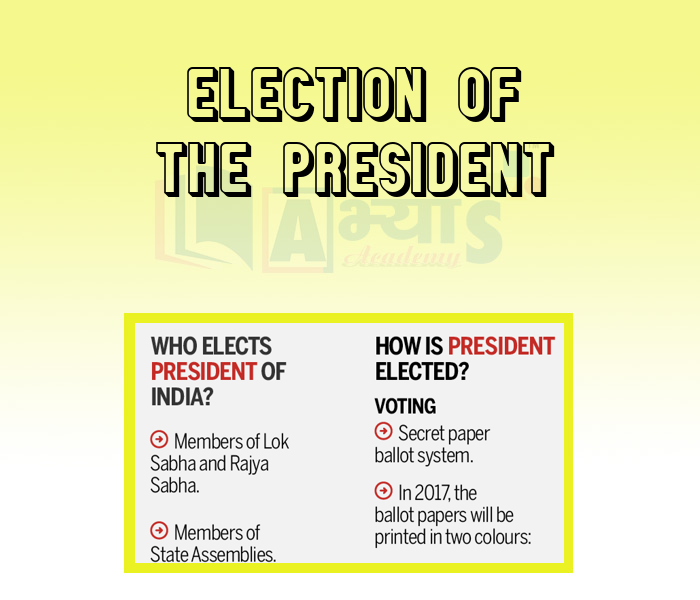Election of the President










Election of the President
The President is elected, from a group of nominees, by the elected members of the Parliament of Indian ( Lok Sabha and Raiya Sabha) as well as of the state legislatures (Vidhan Sabhas), and serves for a term of five years. Incumbents are permitted to stand for re-election. A formula is used to allocate votes so there a balance between the population of each state and the number of votes assembly members from a state can cast, and to give an equal balance between State Assembly members and National Parliament members. If no candidate receives a majority of votes, there is a system by which losing candidates are eliminated from the contest and votes for them are transferred to other candidates, until one gains a majority.
President Election in India
Article 54 mentions that there shall be an election for the President of India.
The President of India is elected indirectly by the single-transferable voting system. The President is elected by an electoral college consisting of elected representatives of the government that form the government after being elected in the state assembly and national elections. The nominated members of both the houses and state legislatures are not allowed to vote in the presidential election. Hence the electoral college of the presidential election consists of:
Which of the following are correct ? (a) The President is elected, from a group of nominees, by the elected members of the Parliament of Indian as well as of the state legislatures. (b) The President serves for a term of five years. | |||
| Right Option : C | |||
| View Explanation | |||
The President of India is elected - | |||
| Right Option : D | |||
| View Explanation | |||
Which of the following are incorrect : (a) The President is elected, from a group of nominees. (b) The President is elected by the elected members of the Parliament of India. (c) The President is elected by of the state legislatures. | |||
| Right Option : D | |||
| View Explanation | |||
Students / Parents Reviews [10]
It was good as the experience because as we had come here we had been improved in a such envirnment created here.Extra is taught which is beneficial for future.

Eshan Arora
8thA marvelous experience with Abhyas. I am glad to share that my ward has achieved more than enough at the Ambala ABHYAS centre. Years have passed on and more and more he has gained. May the centre flourish and develop day by day by the grace of God.

Archit Segal
7thIt was a good experience with Abhyas Academy. I even faced problems in starting but slowly and steadily overcomed. Especially reasoning classes helped me a lot.

Cheshta
10thMy experience with Abhyas academy is very good. I did not think that my every subject coming here will be so strong. The main thing is that the online tests had made me learn here more things.

Hiya Gupta
8thMy experience was very good with Abhyas academy. I am studying here from 6th class and I am satisfied by its results in my life. I improved a lot here ahead of school syllabus.

Ayan Ghosh
8thAbhyas is a complete education Institute. Here extreme care is taken by teacher with the help of regular exam. Extra classes also conducted by the institute, if the student is weak.

Om Umang
10thAbhyas Methodology is very good. It is based on according to student and each child manages accordingly to its properly. Methodology has improved the abilities of students to shine them in future.

Manish Kumar
10thIt has a great methodology. Students here can get analysis to their test quickly.We can learn easily through PPTs and the testing methods are good. We know that where we have to practice

Barkha Arora
10thAbout Abhyas metholodology the teachers are very nice and hardworking toward students.The Centre Head Mrs Anu Sethi is also a brilliant teacher.Abhyas has taught me how to overcome problems and has always taken my doubts and suppoeted me.

Shreya Shrivastava
8thMy experience with Abhyas is very good. I have learnt many things here like vedic maths and reasoning also. Teachers here first take our doubts and then there are assignments to verify our weak points.
